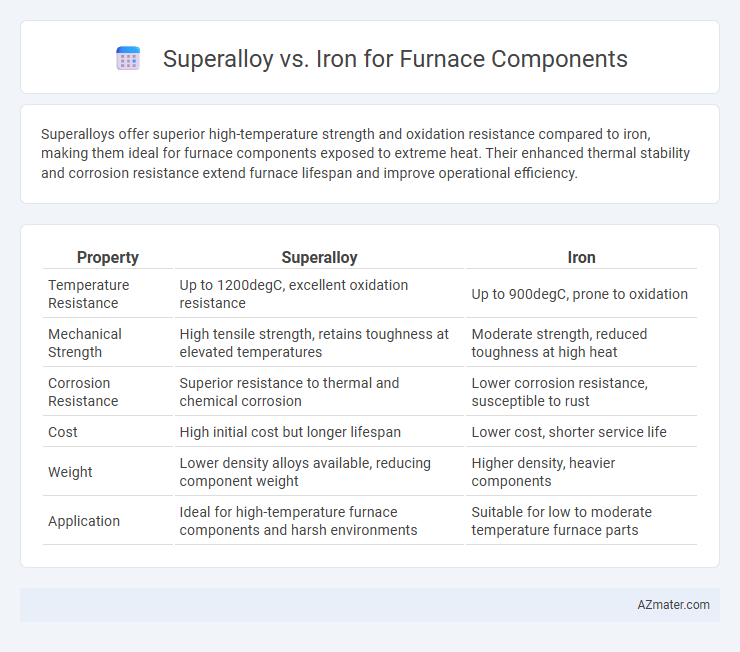Superalloys offer superior high-temperature strength and oxidation resistance compared to iron, making them ideal for furnace components exposed to extreme heat. Their enhanced thermal stability and corrosion resistance extend furnace lifespan and improve operational efficiency.
Table of Comparison
| Property | Superalloy | Iron |
|---|---|---|
| Temperature Resistance | Up to 1200degC, excellent oxidation resistance | Up to 900degC, prone to oxidation |
| Mechanical Strength | High tensile strength, retains toughness at elevated temperatures | Moderate strength, reduced toughness at high heat |
| Corrosion Resistance | Superior resistance to thermal and chemical corrosion | Lower corrosion resistance, susceptible to rust |
| Cost | High initial cost but longer lifespan | Lower cost, shorter service life |
| Weight | Lower density alloys available, reducing component weight | Higher density, heavier components |
| Application | Ideal for high-temperature furnace components and harsh environments | Suitable for low to moderate temperature furnace parts |
Introduction to Furnace Components
Furnace components must withstand extreme temperatures, thermal cycling, and corrosive environments, making material selection critical. Superalloys offer superior high-temperature strength, oxidation resistance, and creep resistance compared to iron, enhancing the durability and performance of furnace parts. Iron, while cost-effective and easier to machine, lacks the long-term stability under severe thermal stress needed for advanced furnace applications.
Overview of Superalloys
Superalloys are advanced metallic materials specifically engineered to withstand extreme temperatures, corrosion, and mechanical stress, making them ideal for furnace components operating under harsh conditions. Composed primarily of nickel, cobalt, or iron-based elements, superalloys maintain structural integrity and resist oxidation better than standard iron alloys. Their superior thermal stability and creep resistance significantly extend the lifespan and performance efficiency of furnace parts compared to conventional iron materials.
Properties of Iron in High-Temperature Environments
Iron exhibits excellent mechanical strength and thermal conductivity in high-temperature environments, making it a reliable material for furnace components. Its high melting point of approximately 1538degC allows it to withstand intense heat without significant deformation. However, iron is prone to oxidation and scaling at elevated temperatures, which can reduce its durability unless protective coatings or alloying elements are applied.
Mechanical Strength Comparison
Superalloys exhibit superior mechanical strength compared to iron when used in furnace components, maintaining high tensile strength and creep resistance at elevated temperatures above 1000degC. Iron, while cost-effective and easier to fabricate, suffers from reduced mechanical integrity and oxidation resistance under prolonged high-heat exposure, leading to deformation and failure. The enhanced alloying elements in superalloys, such as nickel, chromium, and cobalt, contribute to improved microstructural stability and mechanical performance critical for maintaining durability in furnace environments.
Corrosion and Oxidation Resistance
Superalloys exhibit superior corrosion and oxidation resistance compared to iron, making them ideal for furnace components exposed to extreme high-temperature environments. Their complex composition, often including elements such as chromium, nickel, and cobalt, forms stable oxide layers that prevent material degradation. In contrast, iron is more susceptible to rapid oxidation and corrosive attack, resulting in reduced lifespan and increased maintenance costs in furnace applications.
Thermal Stability and Performance
Superalloys exhibit superior thermal stability compared to iron, maintaining structural integrity at temperatures exceeding 1,000degC, which is critical for furnace components exposed to extreme heat. Iron, while cost-effective, undergoes accelerated oxidation and phase degradation above 700degC, limiting its performance in high-temperature environments. The enhanced creep resistance and oxidation resistance of superalloys significantly extend the lifespan and reliability of furnace components under continuous thermal cycling.
Longevity and Maintenance Requirements
Superalloys offer superior longevity compared to iron for furnace components due to their excellent resistance to high temperatures, oxidation, and corrosion, significantly reducing wear and deformation. Iron, while cost-effective, tends to degrade faster under extreme thermal cycling, leading to more frequent maintenance and replacements. Utilizing superalloys minimizes downtime and maintenance costs, enhancing the overall efficiency and lifespan of furnace systems.
Cost Analysis: Superalloys vs Iron
Superalloys exhibit superior high-temperature strength and corrosion resistance compared to iron, but their material and manufacturing costs are significantly higher, often exceeding iron costs by 3 to 5 times. Iron components offer a cost-effective solution with good thermal conductivity and ease of fabrication, making them suitable for lower temperature furnace parts where durability demands are moderate. Choosing between superalloy and iron depends on balancing performance requirements against budget constraints, with superalloys favored for extreme conditions despite their premium price.
Applications and Suitability in Furnaces
Superalloys offer superior high-temperature strength, corrosion resistance, and oxidation resistance, making them ideal for critical furnace components exposed to extreme thermal cycles and aggressive environments. Iron-based alloys, commonly used in lower-temperature furnace parts, provide cost-effective solutions but lack the durability and stability required for prolonged exposure in high-performance industrial furnaces. Selecting superalloys enhances operational lifespan and efficiency in aerospace, power generation, and petrochemical furnace applications where extreme heat and mechanical stress are prevalent.
Conclusion: Choosing the Right Material for Furnace Components
Superalloys demonstrate superior high-temperature strength, oxidation resistance, and thermal stability compared to iron, making them ideal for critical furnace components exposed to extreme conditions. Iron offers cost-effectiveness and good mechanical properties at moderate temperatures but falls short in long-term durability and corrosion resistance under severe thermal cycling. Selecting superalloys ensures enhanced lifespan and performance of furnace parts, justifying their higher initial investment for demanding industrial applications.

Infographic: Superalloy vs Iron for Furnace Component
 azmater.com
azmater.com